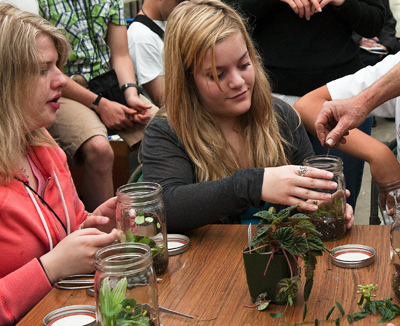A Tour of the Botanical Gardens
"We are going to build a world," proclaimed the representative of the Seattle Botanical Gardens to the intrepid DO-IT Scholars. And it was so. No matter that the alleged world consisted of a small jar. The jar contained a new and original ecosystem, a manufactured one that would prosper in the responsible care of the DO-IT Scholars. Several plants were selected to form the basis of the ecosystem. Then soil was funneled in to serve as a foundation for the plants, so that they might retain nutrients from it. Lastly, worms and similar animals were placed within the jar to provide diversity to the ecosystem. Each and every one of the worms received a special and unique name.

The DO-IT Scholars were impressed with the worlds they built, and they were equally impressed by the accessibility options available at the gardens. Interpreters for the deaf were available. There were also numerous helpers available to assist the blind in the activities. The choices for those in wheelchairs were somewhat limited, however, through no fault of the Botanical Gardens. It is housed in a building that was constructed long before the Americans with Disabilities Act. Nevertheless, many people with wheelchairs said that they didn't mind the limited accessibility, as most of the areas that were not wheelchair accessible were closed off to everyone.
Besides the world building activities, DO-IT Scholars learned about plants in arid areas, and, more importantly, the adaptations that they must make to survive in such a desolate climate. These adaptations particularly resonated with the DO-IT Scholars because it reminded them of their own disabilities and how they transcend such things. Like the plants, some people believed that the Scholars could not succeed in school, at home, in the social arena, and in life. But they were wrong; like the lowly cactus, people with disabilities can excel.